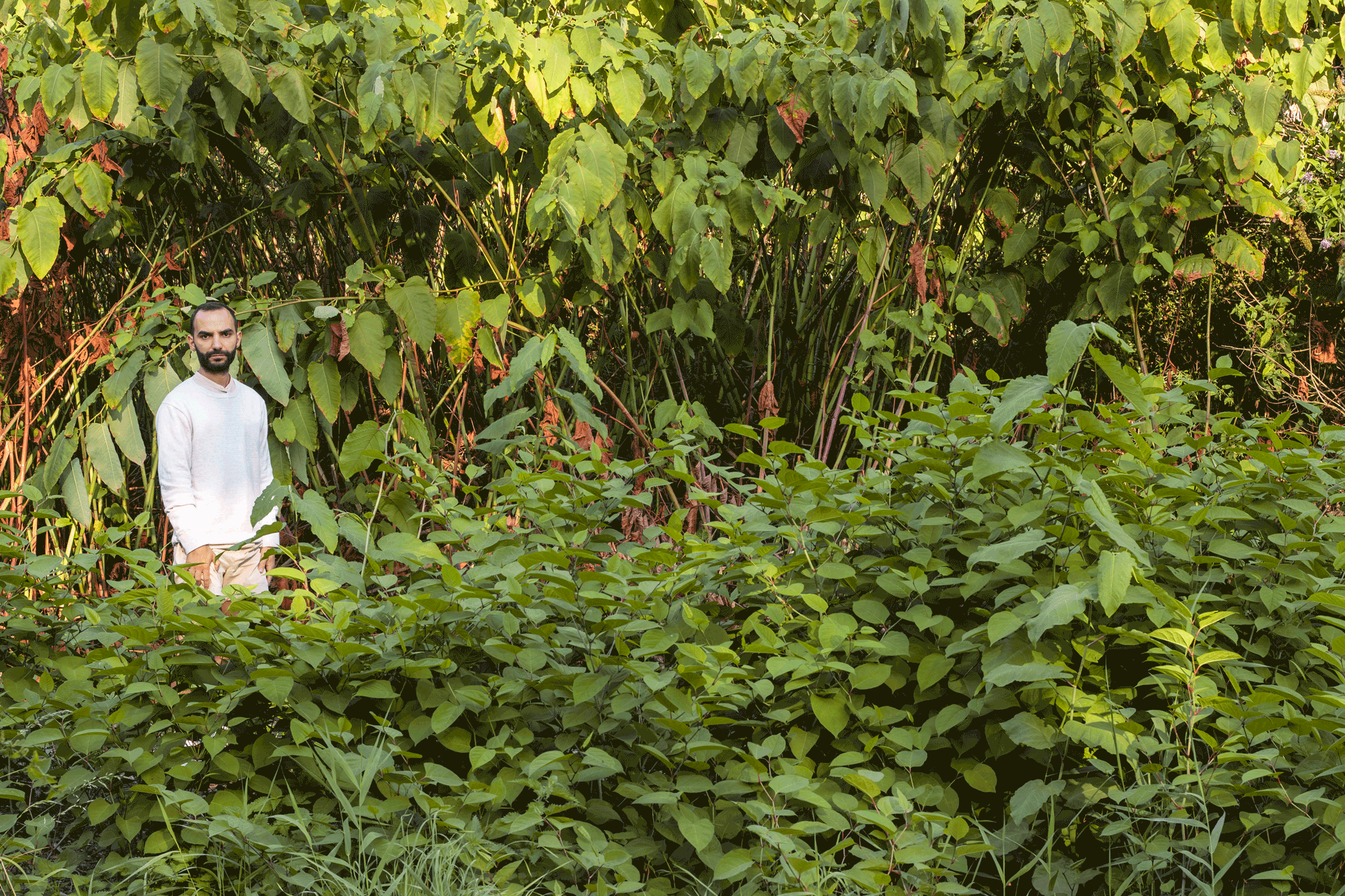THE DOG CHASED ITS TAIL TO BITE IT OFF
Ongoing research, 2019–present
In 1823 Philipp Franz von Siebold sailed under the auspices of the Dutch East India Company (VOC) to Japan, where he used his role as resident doctor and scientist at the Dejima trading post to amass a vast botanical collection. Among the species von Siebold introduced to Europe was Japanese knotweed (Fallopia japonica). Today considered a “non native invasive species” in places like the United Kingdom, the plant is now treated as a scourge. Alaa Abu Asad meditatively traces the violent, xenophobic speech used to describe the plant and its parallels in the language used to describe human migrants.
On a planet where ultimately very little is truly native, Abu Asad questions which plant species become accepted as the rightful inhabitants of nation states over time and which are forever relegated to the foreign. Tulips, though first imported to Holland from the Ottoman Empire in the sixteenth century, are today proudly claimed a national treasure. No such fate has met the Japanese knotweed. The plant remains pursued across countries and continents as every conceivable attempt is made to eradicate it.
Japanese knotweed survives where other species cannot. Its nonhierarchical root system enables it to thrive in industrial wastelands, erupt through concrete, and even disrupt electrical lines. And yet little thought is given to the underlying causes aiding this plant to flourish, from pollution to reduced frost brought on by climate change. The plant is blamed for the wrongdoings of others in the name of expediency and self-preservation. For Abu Asad, these plants reveal to us the human condition. Even as many try to expunge it from the earth, Japanese knotweed’s resilience continues to insist on presence.
Amanda Sarroff for Van Eyck Academy open studios, 2020


Performative reading “In the absence of the invasive: Can we finally look at the Japanese knotweed as a green future companion?”
APRiCot Garden 2025: Research as Regenerative Practice, Dutch Art Institute hosted by the Nieuwe Instituut in Rotterdam, 2025
Photos credit: Nikos Doulos, courtesy DAI


New World Order, exhibition view at John Hansard Gallery in Southampton, Summer Programme 2025
Photos credit: Reece Straw & the artist

Japanese knotweed sticks, Krzyżowa, 2024

Japanese knotweed rhizome, Krzyżowa, 2024


Performative reading “In the absence of the invasive: Can we finally look at the Japanese knotweed as a green future companion?”, during ‘yellow brick, blue brick, perpetually’, a group exhibition curated by Sjoerd Beijers . B32 Maastricht, 2024
Photo credit: Johan Poezevara


Harvesting Japanese knotweed dry stems at Westerpark in Amsterdam, 2024
Neo Futurist Dinner #17 - Knots, Weeds & Roots, with Asli Hatipoglu and Uno Fujisawa, Mediamatic, 2024

Freedom Meal: a dinner about Japanese Knotweed, with Asli Hatipoglu and Uno Fujisawa,
May 5, 2023, Mediamatic Amsterdam

Japanese knotweed leaves and sticks.
Credits: ©Kunstfort bij Vijfhuizen, 2023.
Photo: Thaddeus Photography

Installation view, De Aanschouw, Rotterdam,
Curator: Kuan Yen-Ting.
Photo: Florian Cramer, 2023

Japanese knotweed in blossom (right), Ghent, August 2022

Japanese knotweed in blossom, Ghent, September 2022

Self portrait(s) between Sakhalin and Japanese knotweeds in Ghent, 2022

Future companion, Timelab, Ghent, 2023



Handmade research book, 11x8x2.5 cm (LWH), 2020. Cover image: Eriz Moreno

Installation view, Mediamatic, Amsterdam, 2023


Installation detail: research terms translated into Arabic, digital image of a book cover, and a Japanese knotweed dry stem. Photo credit Romy Finke (Van Eyck Academy) 2020

Japanese knotweed expansion in the Netherlands between January 2012 and July 2020. Please bear in mind both the seasons cycle and the life cycle of the plant as it dies in winter and regrows anew in spring. The many local and national campaigns and attempts to kill the plant using different methods (varying from chemical herbicides like glyphosate to trimming and soil coverage and digging) play another role in the plant growth as well.
Installation view from Weed Control exhibition at AMQF in Ramallah, 2020

Installation detail: Victorian imperial botany. Working tools, handmade research book and research material, Jan Van Eyck Academy, Maastricht, 2020

Installation view: research material, 3-months-old JK plant, JK dry sticks, and working tools. KKA Vienna, 2019
Supported by

